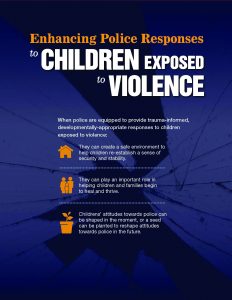Millions of children and adolescents in the United States are exposed to violence as victims or witnesses in their homes, schools, and communities every year. Findings from the second National Survey of Children’s Exposure to Violence (NatSCEV II), conducted in 2011, revealed that more than half of the children in the United States have been exposed to or have witnessed violence, crime, and abuse, including domestic violence, dating violence, sexual assault and stalking, school violence, community violence, or property victimization. Research also shows that the exposure to violence in childhood has significant immediate and longer-term emotional and physical consequences for those exposed.1 When children are not identified and supported in recovery following their exposure to violence, they are at greater risk for the following:
• School failure
• Mental health disorders such as anxiety, depression, post-traumatic stress disorder (PTSD), and personality disorders
• Substance abuse disorders
• Involvement with the juvenile and criminal justice systems
• Repeated victimization and perpetration of sexual and physical violence, as well as domestic violence
• Perpetration of community violence
• Chronic physical illness
• Early death2
While the consequences of childhood exposure to violence are substantial, there are opportunities to intervene and make a difference in the lives of vulnerable children. Law enforcement officers play a major role in the lives of vulnerable children and can be a key protective factor, along with family, schools, and the community, all of which can be critical in changing the trajectory toward the negative outcomes often associated with childhood trauma and violence.
|
Because of their role in responding to calls for service as well as their ongoing presence in the communities they serve, officers are uniquely positioned to recognize children who might be at risk following exposure to violence. They also are well placed to utilize trauma-informed practices—both immediately on scene and beyond the emergency calls for service—to initiate children’s recovery. However, until recently, professional development and tools designed to enhance law enforcement’s ability to identify and respond to children exposed to violence (CEV) using trauma-informed policing strategies were not widely available. Recognizing the need and the opportunity to fill this critical gap, the International Association of Chiefs of Police (IACP) and the Child Study Center at the Yale School of Medicine, in partnership with the Office of Juvenile Justice and Delinquency Prevention (OJJDP), Office of Justice Programs, U.S. Department of Justice, joined forces to develop the Enhancing Police Responses to Children Exposed to Violence: A Toolkit for Law Enforcement (the Toolkit).
The core content of the Toolkit is based on principles, practices, and approaches developed at the Childhood Violent Trauma Center at the Yale Child Study Center (Yale) over 25 years and through the implementation of the Child Development-Community Policing (CD-CP) program in New Haven, Connecticut, and Charlotte, North Carolina. Building on the knowledge and expertise gained through the CD-CP program, the Toolkit is designed to meet the distinctive needs of today’s law enforcement officers, who might or might not have the opportunity to work in close collaboration with trauma-informed mental health and child welfare professionals.
The Toolkit contains field-tested and research-informed resources developed specifically to enable law enforcement leaders and frontline officers to improve responses to children who have been exposed to violence. The tools are organized into four types.
Overview
• A Law Enforcement Executive’s Brief on Children Exposed to Violence
• The Officer’s Role in Responding to Traumatized Children
Assessment Tool
• Organizational Self-Assessment Tool and Action Planning Tool
Operational Protocols
• On-Scene Acute Protocol for Children Exposed to Violence
• Protocol for Responding to the Needs of Children at Scenes of Domestic Violence
• Principles and Practices of Death Notification to Children
Operational Tools
• Reactions That Police May Observe from Children and Youth
• What Traumatic Stress Reactions May Look Like On Scene
• Effective Police Responses to Traumatic Stress in Children of Different Ages
• Commonly Asked Questions from Children and Example Police Responses
• Common Issues with Caregivers and Police Responses
• What to Do When Your Child Is Exposed to Violence (brochure)
• Teaching the Tactical Breathing Technique to Children and Parents
For more information on how law enforcement professionals can most effectively respond to the needs of children exposed to violence, visit the project webpage.
|
Steps for Police Leaders Enhance an agency’s response to children and families exposed to violence by |
Notes:
1David Finkelhor et al., Children’s Exposure to Violence, Crime, and Abuse: An Update, National Survey of Children’s Exposure to Violence (Washington, DC: U.S. Department of Justice, Office of Justice Programs, Office of Juvenile Justice and Delinquency Prevention, 2015).
2Vincent J. Felitti et al., “Relationship of Childhood Abuse and Household Dysfunction to Many of the Leading Causes of Death in Adults: The Adverse Childhood Experiences (ACE) Study,” American Journal of Preventative Medicine 14, no. 4 (1998), 245–258.
Please cite as
Kelly Burke and Hilary Hahn, “Trauma-Informed Policing: Responding to Children Exposed to Violence,” IACP Working for You, The Police Chief (August 2017): 94–95.


 Police Officer’s Role in the Lives of Children Exposed to Violence
Police Officer’s Role in the Lives of Children Exposed to Violence